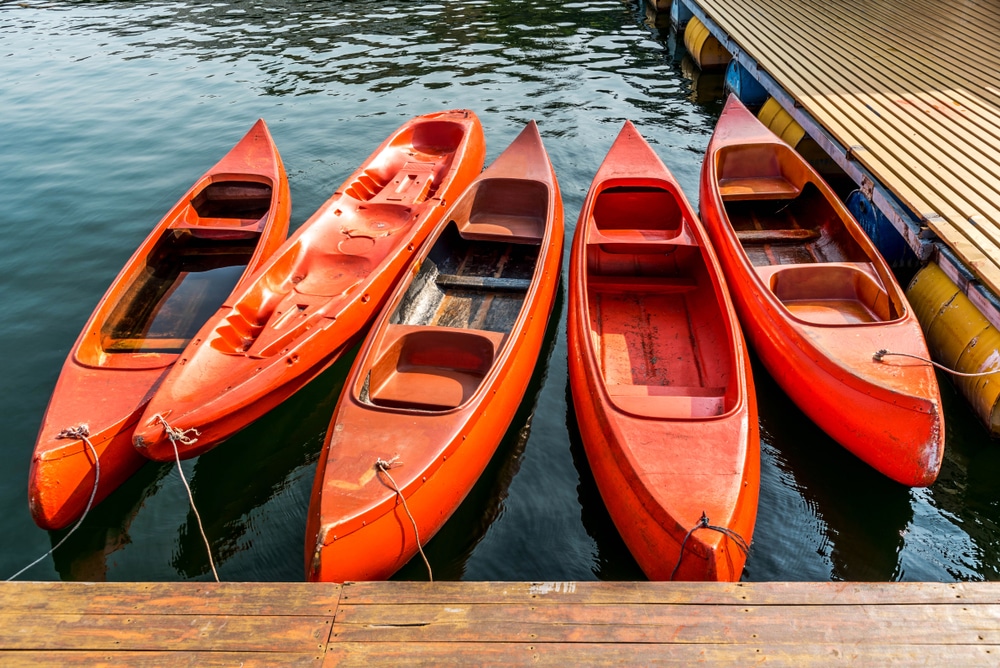Table of Contents
Kayak weight matters more than what a paddler thinks. Kayak weight affects performance, efficiency, and transport on the water. Whether you are a beginner or a professional paddler, knowing the weight capacity and how much a kayak weigh when selecting is essential. Each kayak has a different weight capacity, whether it is a tandem kayak, fishing kayak, or recreational kayak. In this detailed guide, we’ll explore the various types of kayaks and their weights and answer your frequently asked question: How much does a kayak weigh?
Understanding Weight Capacity

The weight capacity is essential to determining whether it can accommodate the combined weight of the paddler(s), equipment, and additional items. Therefore, each kayak has a weight limit that specifies the maximum weight it can safely hold.
Maximum weight limit
This is the highest weight the kayak can handle without compromising its stability and performance. Depending on the kayak’s size and form, this limit often varies from 250 to 600 pounds.
Maximum weight capacity
The term “maximum weight capacity,” which is synonymous with “maximum weight limit,” is crucial to know how much weight the kayak can support overall, including the weight of the paddler and any gear. The maximum capacity of a kayak is determined by three things:
- Length
- Width
- Displacement (volume)
Weight limit
This is a general term that includes the maximum weight capacity and the maximum weight limit. It shows how much weight the kayak can support overall without compromising its use or safety.
Types of Kayaks and Their Weights

Among the several types of kayaks, each type of kayak weigh differently from the others.
1. Recreational kayaks
Recreational kayaks are perfect for beginners because they are easy to use and are more stable. They are designed for paddling on calm rivers, serene lakes, and bays.
- The average weight typically ranges from 30 to 50 pounds.
- Recreational kayaks offer larger cockpits for convenient entry and exit and wider beams for stability.
- Typically made up of polyethylene or other durable polymers that provide a balance between strength and weight.
2.Sea kayaks
Sea kayaks are designed for longer excursions and open waters. They are designed to travel long distances and withstand challenging circumstances.
- Generally falls between 50 to 70 pounds.
- This kayak is narrower and longer than a recreational kayak and features storage compartments and stronger hulls for managing waves.
- Modern composites, carbon fiber, or fiberglass are frequently used in construction for less weight and greater strength.
3. Tandem kayaks
Tandem kayaks are made to hold two paddlers each. They are perfect for paddling with friends, family, or couples.
- Usually between 60 to 90 pounds.
- It features two sets of seats and footrests, which are longer than single kayaks. They are designed to support the weight of two paddlers with gear.
- They can be constructed using the same materials as single kayaks, although they usually have stronger construction to handle more weight.
4. Inflatable kayaks
Inflatable kayaks are renowned for being portable and simple to store. If you’re looking for something compact and lightweight, they’re a great option.
- The weight varies based on size and number of paddlers, from 20 to 40 pounds.
- Made from durable, puncture-resistant materials with air chambers for buoyancy and stability.
- Usually made of Hypalon or PVC, which provide a good mix between durability and weight.
5.Sit on top kayaks
The open cockpit of sit-on-top kayaks is great for warm weather and convenient access.
- This kayak weigh usually falls between 40 to 60 pounds.
- Due to their open form, they offer less weather protection than sit-in kayaks, but getting in and out of them is easier.
- Roto-molded plastic is frequently used since it is reasonably lightweight and sturdy.
6. Touring kayaks
Touring kayaks are primarily used for long-distance touring and various water conditions. They provide improved performance for longer paddling journeys.
- A touring kayak typically weigh between 50 to 70 pounds.
- Because they are long and narrow, designers make them fast and capable of tracking well. The key features include multiple storage compartments and adjustable seating.
- To balance weight and performance, manufacturers frequently use new polymers or lightweight composites.
Fishing Kayaks
Designed with fishermen in mind, fishing kayaks have a number of characteristics that improve the fishing experience.
- Usually in the range of 50 and 80 pounds.
- Include extra tackle storage, bait wells, and rod holders, among others. It is designed to provide comfort and stability for long-term use on the water.
- Made of sturdy polymers or composites to support the weight of the additional fishing accessories and equipment.
Advanced Kayak Types and Weigh

Other than the above-mentioned kayaks, several different types of kayaks are designed for specialized purposes, each with unique weight characteristics.
Whitewater Kayaks
Whitewater kayaks are designed for navigating rapids and rough river conditions. They are typically shorter and more maneuverable than other types of kayaks.
- Average Weight: Generally between 20 to 40 pounds
Surf Kayaks
Surf kayaks are designed specifically for surfing waves. They are crafted to combine the features of a surfboard and a kayak.
- Average Weight: Typically between 20 to 35 pounds
Racing Kayaks
- Average Weight: Generally, between 20 to 30 pounds.
This is a detailed analysis of how much each kayak weigh and the maximum weight capacities of different types of kayaks.
| Type of kayak | Weight capacity |
| Recreational kayaks | 30-50 pounds |
| Sea kayaks | 50-70 pounds |
| Tandem kayaks | 60-90 pounds |
| Inflatable kayaks | 20-40 pounds |
| Sit on top Kayaks | 40-60 pounds |
| Touring kayaks | 50-70 pounds |
| Fishing kayaks | 50-80 pounds |
Does Kayak Weigh Matters?
Several key factors determine how much a kayak weigh in addition to its size.
Materials
- Polyethylene: Durable and relatively heavy, commonly used for recreational kayaks.
- Fiberglass: Used in sea and touring kayaks, it is more rigid and lighter.
- Carbon fiber: It is incredibly robust and lightweight in pricey, high-performance boats.
- Pvc: This material, which balances weight and durability, is used in inflatable kayaks.
Size and dimensions
The kayak’s length, width, and height influence its weight. Wider and longer kayaks are usually heavier but provide more stability and capacity.
Design and features
added features like integrated storage compartments, adjustable seat combinations, and additional reinforcement increase the kayak’s total weight. A kayak with several compartments or a solid framework, for example, will weigh more than one with a simpler design.
Construction techniques
The material and the technique used in the construction of a kayak also impact how much a kayak weigh. The technique used to build the kayak, such as hand-laying composites or roto molding, determines its weight. Thus, kayaks made of rotomolded plastic are usually more durable and heavier than composite kayaks, which are lighter but frequently more costly.
Transportation
Heavier kayaks often require a roof rack or a kayak cart for easier transport of kayak. You can carry lighter kayaks by hand, but consider the distance and how easy they are to handle.
Storage
Does Kayak Weigh Affect Paddling Experience?

Yes, kayak weigh affects the paddling experience in a number of ways:
Heavier kayaks
Although heavier kayaks are more durable and stable, they can be more difficult to move and handle. The extra weight may impact the kayak’s speed and maneuverability.
Lighter kayaks
Lighter kayaks are more maneuverable and can increase paddling efficiency. Thus, they are also easier to carry and transport. In contrast to heavier models, however, they could provide less stability in challenging situations.
Water line
The kayak’s weight affects its water line or how much of it sits below the surface of the water. An overweight kayak may sink deeper into the water, affecting its stability and performance.
Conclusion
I conclude that kayak weight is a crucial factor in choosing the best kayak for yourself. Each type of kayak offers different benefits and features that can enhance your paddling experience. By considering the kayak weigh and maximum weight capacity, you can select the best kayak for your needs and enjoy a safe and enjoyable time on the water. By understanding how much a kayak weigh capacities in this article, you can now make an informed choice regarding the selection of kayak for your intended uses and preferences. Each type of kayak, whether recreational, sea kayak, tandem kayak, inflatable kayak, sit-on-top kayak, touring kayak, or fishing kayak, has its distinct features and intended use.
